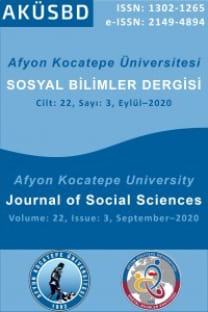Uzay Turizmine İlişkin Uluslararası Turizm Karikatürlerinin Göstergebilimsel Bir Analizi
Uzaya ulaşabilmek, farklı gezegenlerde hayat kurmak, gezegenler arasında seyahat edebilmek, Ay’a gitmek geçmişten günümüze kadar insanların hayalini kurduğu bir olgudur. Bu olgu doğrultusunda şekillenen turizm türü uzay turizmidir. Uzay turizmi, uzay turisti olarak adlandırılan turistik tüketicilerin temel uzay gözlemlerinden uzay eğitimlerine, sıfır yer çekimi ortamından uzay uçuşlarına kadar geniş bir faaliyet alanı sunmaktadır. Bu araştırmanın amacı geleceğin trendlerinden biri olacağı düşünülen uzay turizmine ilişkin yaklaşımların tespit edilmesi ve genellenebilmesidir. Kişilerin uzay turizmini, uzay otellerini nasıl yorumladığı, uzayda yapılabilecek faaliyetlere ilişkin görüşlerinin ne yönde olduğu gibi çıkarımlar araştırmanın temel sorunudur. Araştırma yöntemi olarak göstergebilimsel analizlerden yararlanılmıştır. Saussure ve Barthes modellemelerine dayalı bir analiz yaklaşımının esas alındığı araştırmada Sekizinci Uluslararası Turizm Karikatürleri Yarışması Albümünde yer alan uzay turizmi karikatürleri örnekleme olarak belirlenmiştir. Alanyazın incelendiğinde uzay turizmi ve göstergebilim etkileşimini ele alan araştırmalar olmadığından yorumsayıcı bakış açısıyla bu boşluğun doldurulması hedeflenmektedir. Araştırmadan elde edilen sonuçlar derlendiğinde yarışmaya katılan kişilerin uzay turizmi ile klasik turizm türleri arasında bir bağlantı kurmaya çalıştıkları, klasik turizm türlerinin değerini kaybedeceği ve uzay turizminin yaygın hale geleceği yönündedir. Uzay otelleri daha çok lüksü ve konforu çağrıştırarak çizilmiştir. Uzay ulaşımı için çizilen karikatürlerin ana teması ise uzay yolculuğunun sıradan bir olgu olacağı şeklindedir.
A Semiological Analysis Of Space Tourism Related International Tourism Caricatures
Reaching to space, starting a life on other planets, travelling between planets, going to the moon, are phenomena people dream about from the past to the recent day. The type of tourism shaped by thisphenomenon is space tourism. Space tourism offers a wide range of activities ranging from basic space observations to space trainings, from zero gravity to space flight for the touristic consumers called space tourists. The aim of this study is to identify and generalize the approaches related to space tourism, which is thought to be one of the future trends. Inferences, such as how people interpret space tourism and space hotels, and how they think about activities that can be done in space, is the main problem of the research. In this context, semiological analyses were used as a research method. In the study, which is the starting point of Saussure and Barthes’ modellings, space tourism caricatures in the 8th International Tourism Caricature Competition Album, are determined as the sampling. Because of the lack of studies that discuss the interaction of space tourism and semiology in the literature, filling this gap with an interpretive perspective is needed. When the results obtained from the study were compiled, it was observed that the participants of the competition tried to establish a connection between space tourism and classical tourism types. Another result of the study is in the line with classical tourism types losing their value and space tourism becoming more widespread. Space hotels are mostly drawn by evoking luxury and comfort. The main theme of the caricatures drawn for space transportation is that space travel will be an ordinary phenomenon.
Keywords:
Space tourism, space tourist orbital hotels, semiotics,
___
- pel, U. (1997). Space Tourism a Promising Future, Space Policy, 13(4): 279-284.
- Billings, L. (2006). Exploration for the Masses? or Joyrides for the Ultra-Rich? Prospects for Space Tourism, Space Policy, 22: 162-164.
- Berry, J. (2012). State, Capital and Spaceships: A Terrestrial Geography of Space Tourism, Geoforum 43: 25–34.
- Cater, C. I. (2010). Steps to Space; Opportunities for Astrotourism, Tourism Management, 31: 838-84.
- Chang, Y. W. ve Chern, J. S. (2016). Ups and Downs of Space Tourism Development in 60 Years from Moon Register to Spaceshiptwo Crash, Acta Astronautica, 127: 533-541.
- Chang, Y. W. (2017). A Preliminary Examination of the Relationship Between Consumer Attitude Towards Space Travel and the Development of Innovative Space Tourism Technology, Current Issues in Tourism, 20(14): 1431-1453.
- Cohen, E. (2017). The Paradoxes of Space Tourism, Tourism Recreation Research, 42(1): 22- 31.
- Collins, P. (2006). Space Tourism: from Earth Orbit to the Moon, Advances in Space Research, 37: 116-122.
- Crouch, I. G. (2001). The Market for Space Tourism: Early Indications, Journal of Travel Research, 40: 213-219.
- Forganni, A. (2017). The Potential of Space Tourism for Space Popularisation: An Opportunity for the EU Space Policy? Space Policy, 41: 48-52.
- Goehlich, R. A., Anderson, K. J., Harrold, N. N., Bemis, J.A., Nettleingham, M. T., Cobin, J. M., Zimmerman, R. B., Avni, B.L., Gonyea, M.D. ve Ilchena, N. C. (2013). Pilots for Space Tourism, Space Policy, 29: 44-15.
- Hobe, S. (2010). The Legal Regime for Private Space Tourism Activities-An Overview, Acta Astronautica, 66:1593-1596.
- Johnson, M. R. ve Martin, D. (2016). The Anticipated Futures of Space Tourism, Mobilities, 11(1): 135-151.
- Loizou, J. (2006). Turning Space Tourism Into Commercial Reality, Space Policy, 22: 289-290.
- Prideaux, B. ve Singer, P. (2005). Space Tourism-A Future Dream or a Cybertourism Reality?, Tourism Recreation Research, 30(3): 27-35.
- Sekizinci Uluslararası Turizm Karikatürleri Yarışması Albümü (2016). Uzay Turizmi Karikatürleri,https://anatoliajournal.com/kulliyat/8-uluslararasi-turizm-karikaturleri yarismasi-albumu-post/ (Erişim Tarihi: 10.03.2019).
- Smith, V. L. (2000). Space Tourism: The 21st Century Frontier, Tourism Recreation Research, 25(3): 5-15.
- Spencer, J. (2004). Space Tourism: Do You Want to Go?, Ontario: Apogee Books.
- Strickland, P. (2012). Do Space Hotels Differ from Hotels on Earth? The Mystery is Solved, Journal of Hospitality Marketing and Management, 21(8): 897-890.
- Webber, D. (2013). Space Tourism: Its History, Future and Importance, Acta Astronautica, 92: 138-143.
- ISSN: 1302-1265
- Yayın Aralığı: Yılda 4 Sayı
- Başlangıç: 1999
- Yayıncı: Afyon Kocatepe Üniversitesi Sosyal Bilimler Enstitüsü
Sayıdaki Diğer Makaleler
Küreselleşme Sürecinde Yeni Bir Boyutta Güvenlik Anlayışı ve Çevresel Etkileri
Yerli ve Yabancı Gazetelerde Büyükelçi Krizi
Reklamlarda Metaforik Öğelerin Kullanımı: Kozmetik Reklamları Örneği
Türkiye’de Finansal Krizlerin Öncü Göstergelerle Tahmini
Osmanlı Kudüs’üne Ait H. 1195/ M. 1781 Tarihli Keşif Defteri (Değerlendirme ve Transkripsiyon)
Afyonkarahisar Yorganlarının Teknik, Desen ve Kompozisyon Özellikleri
